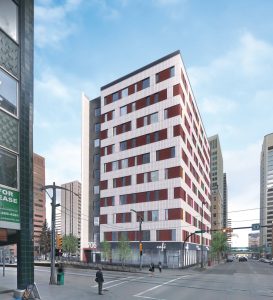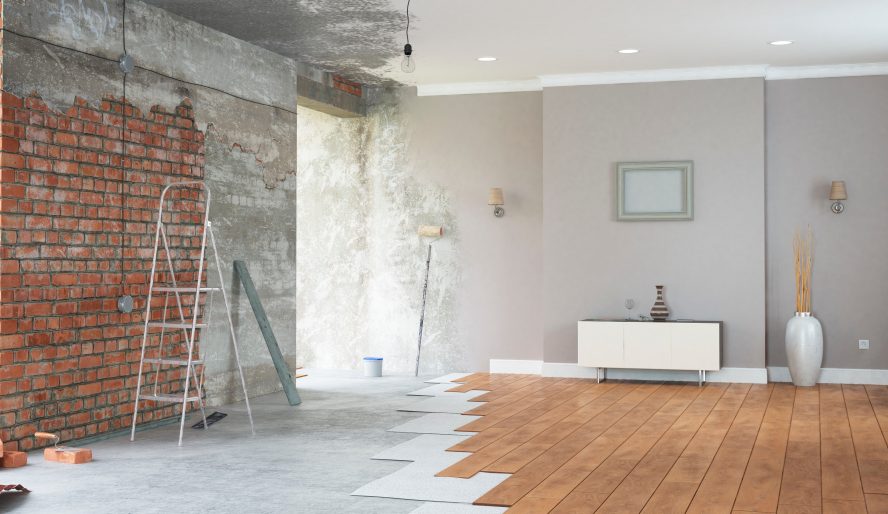Office-to-residential building conversions have been gaining momentum in some jurisdictions, particularly in urban centres hard-hit by the economic fallout of COVID-19. As new strains of the virus continue to circulate and many workers resist returning to the office, some cities, like Calgary, have been left with a surplus of unused commercial space amid the interrelated housing and climate crises.
To contend with the glut of vacant commercial buildings and revitalize its downtown core, the city launched the Downtown Calgary Development Incentive Program in 2021, offering grants to help facilitate office-to-residential building conversions. As of mid-October, a total of seven projects had received a grant, and 665,000 square feet of unused office space has since been replaced with 707 new homes.
Among those projects was Neoma, an office-turned-affordable-rental-building run by the non-profit housing provider, HomeSpace Society. The conversion took about six months to complete at a cost of $30 million. Funding came from multiple sources, including $16.6 million from the Rapid Housing Initiative; $2 million through the Canada-Alberta Bilateral Housing agreement under the National Housing Strategy; and $5.5 million from the City of Calgary’s downtown revitalization program. Private donors also raised nearly $6 million toward the extensive renovations required to repurpose the 10-storey building into private, livable homes.
 “By investing in projects like Neoma, we’re creating a downtown where low-income families, seniors and newcomers can build their lives with access to key amenities just a short walk away,” said Calgary Mayor, Jyoti Gondek, at the official opening in September. “Calgary is proud to be leading the country with this project that will serve as a blueprint for cities looking to address both the housing crisis as well as downtown revitalization.”
“By investing in projects like Neoma, we’re creating a downtown where low-income families, seniors and newcomers can build their lives with access to key amenities just a short walk away,” said Calgary Mayor, Jyoti Gondek, at the official opening in September. “Calgary is proud to be leading the country with this project that will serve as a blueprint for cities looking to address both the housing crisis as well as downtown revitalization.”
While not all building conversions will offer this same noble mix of affordable rental units, shelter spaces, and transitional housing to help families in need, there is no question that more rental housing is needed arguably everywhere. Will building conversions pick up speed and be widely embraced as a viable housing solution? The answer, according to Sheila Botting, Principal & President, Americas Professional Services, Avison Young, is complicated.
“Given most governments are taking an active role in spurring rapid housing development, we could certainly see more conversions happening in Canada,” she said. “On its own as a single solution, it won’t deliver the substantive number of new housing units needed to meet the demand across Canada’s major cities…but every little bit helps.”
First off, Botting points out that some properties—i.e., those of a certain vintage—are more likely to be considered for an office-to-residential project than others, particularly if they are well-located.
“Office tenants today are drawn to trophy, A-Class buildings with higher-quality amenities like fitness centres, cafeterias, and coffee shops—spaces that foster opportunities for collaboration, brainstorming and engagement,” she said. “Employers and building owners that want to attract back their current employees and bring in new talent are relying on these things to help them achieve that goal.”
Increasingly, older C-Class buildings will be challenged by this flight to quality as leases come up for renewal, making them obvious targets for office-to-residential projects, especially those buildings with historic significance or character in downtown and midtown areas. But regardless of age or quality, Botting says there are some practical challenges building owners should be aware of before considering a conversion.
“Floor plates should be in the 8,000 and 14,000 square feet range for a project to be feasible,” she said. “Buildings with very large floor plates are impractical in that they are too deep with limited windows. Also, inserting plumbing for kitchens and bathrooms can be expensive, and older buildings may not have the required infrastructure for a residential environment, with sufficient parking, staircases, access, etc.”
In some cases where the infrastructure is inadequate, it might make more sense to demolish the pre-existing building and replace it with a brand-new high-rise apartment to deliver the needed housing units, particularly in Toronto and Vancouver where higher density land values justify conversion.
“Challenges in these cases might arise from municipalities reluctant to give up commercial space and employment land with high tax-paying, job-creating tenants,” she warned. “So, while this strategy represents one of many options to bring more housing to market, it isn’t a viable solution on its own to meet housing need across Canada. Other solutions include unlocking surplus land and dedicating this to future affordable housing, which we are now seeing happening by the City of Toronto and Province of Ontario. Converting employment land could provide another similar option from the private sector.”
Ultimately, Botting’s take on building conversions is that if the project checks all the boxes in terms of the physical asset, infrastructure, zoning, location, and having support from partners and government funding, it will likely see a successful outcome worthy of the initial investment. But unless all the boxes are checked, the risks of undertaking a conversion project will likely outweigh the rewards.





